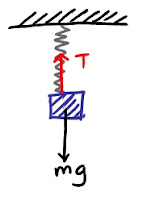Consider a light helical spring that obeys Hooke's law. Now, let us hang a mass m on the spring and gently lower the mass till the spring extends to an new equilibrium length. If the net extension of the spring is e,
(a) What is the loss in the gravitational potential energy of the mass?
(b) What is the gain the elastic potential energy of the mass?
(c) Compare the two answers, why are they different?
Most of the students who did this question, could easily deduce the answers to the first two parts
(a) The loss in the g.p.e. was mge. and
(b) The gain e.p.e was 1/2 ke2. Now, from Hooke's Law, mg = ke. Therefore gain in E.P.E can be written as 1/2 mge.
(c) Comparing the two answers, we see that 1/2 mge went missing.....
Most students at this point in time would then ask two questions. First, "Where did half the energy go to?" the next is that "Is it possible to show that 1/2 the energy would be lost?"
- So let us try to tackle the first question: Where did half the energy go to?
Initially, the spring is unstretched and the mass only experiences a downward force mg. By Newton's 2nd Law, it would therefore also experience a downward acceleration and causes it to gain speed as it moves down. However, as it stretches T increases and the acceleration becomes smaller. Neverthless, before reaching the equlibrium point, it still has a downward acceleration and hence will still gain speed. As it reaches the equilibrium point, T = mg. Although net force is zero, it already has velocity and hence should continue to move down. And as it has velocity at the equilibrium point, it also possesses kinetic energy. And in fact 1/2 of the loss of GPE would hav been converted to E.P.E at that point.
The trick in this question is therefore, the point that in reality the mass was "gently lowered" to the point of equilibrium and hence there should have been a 3rd external force acting on the system that is doing negative work on the system so that it dissipates the kinetic energy that could have been gained.
No, conservation of energy was not violated. The loss in GPE was not all converted into Elastic PE of the spring as this was not a closed system, there was an external force acting on the system and it did negative work on the system, dissipating the rest of the energy.
The favourite question by my better students at this point would often be " Would you be able to further convince us that the work done by this force is exactly 1/2 mge as well?"
Remember, calculus is not a requirement in A-levels, therefore, not to deter my students with the Math, I decide to adopt the graphical approach. (Though calculus is not required, they are expected to know
is area under the y vs. x graph. Anyway, they have learnt this in their secondary school math as well.)
So we simplify the problem as such, consider that an external force F acts on the mass (e.g. like a hand) such that it applies a force in such way to lower the mass into the equilibrium so slowly that the mass may be considered to be moving at a constant rate and almost at rest.
Hence, there are three force T, F and mg on the mass m and F = mg - kx, where x is the extension of the spring.
The work done by the external force F is therefore the area under the F-x graph.
Now, from F = mg - kx. The graph of F vs. x is a straight line graph, with y-intercept mg and gradient -k. Sketching the graph, and noting that at equilibrium, F = 0 and x=e. We see that area under the F-x graph which is the work done by F is therefore exactly 1/2 mge.
F acts in opposite direction to the motion, and hence this work done is actually negative and it seeks to dissipate the kinetic energy that could have been gained.
Hope this answers the question!




No comments:
Post a Comment